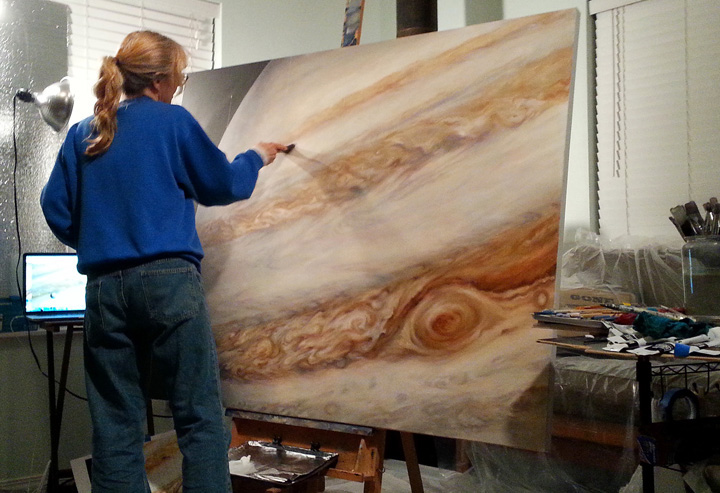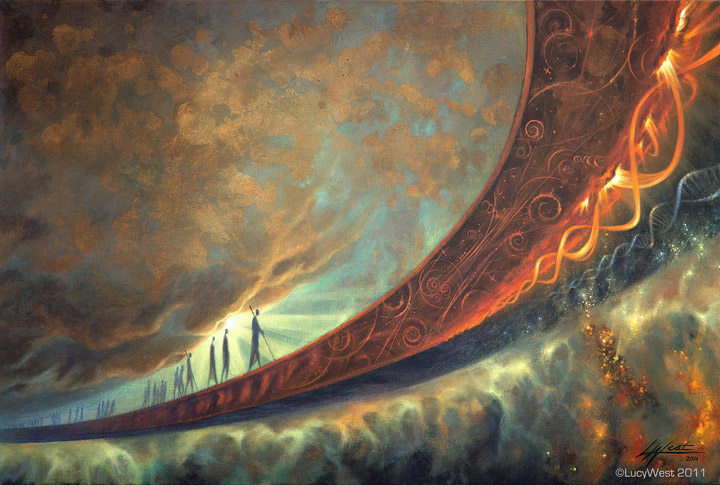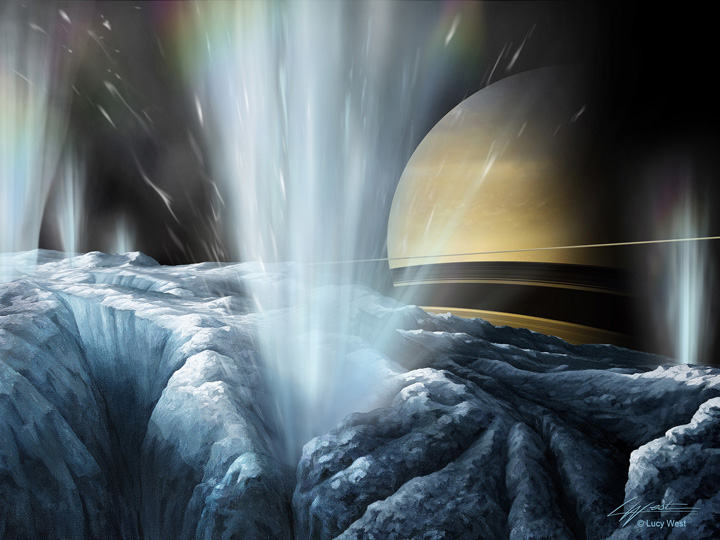- Published: Monday, July 25 2016 15:33
Art Plus Science Equals Fun

"Lucy at the easel painting Jupiter"
Growing up there was never any doubt in my mind that I would become a professional artist. But what has surprised me is how the arts led to my love of science. Over the last decade I’ve realized I get very excited about science, engineering and how nature works, and how that has influences what I paint. It was my artistic nature that first took notice of the beauty in geology, astronomy, astrophysics and planetary science. The more I studied these veins the more I began to see the beauty of science in general. I find these two disciplines, art and science, employ similar techniques of questioning and action, both experience similar flashes of insight, both are motivated by the spell of inspiration to discover something new, both compel to explore the unknown. Science is creative, science is learning. Learning is what inspires me to paint and I use my creativity as a learning tool.
I didn’t always paint scientifically based subjects or even consider science that often in my younger years, but I have always approached art in a scientific way; by studying, researching and dissecting the subject I’m interested in to better understand them before I approach the canvas. I’ve learned much about many different topics because of this method. Basically, art has been a life-long learning tool that I’ve used it to investigate a broad spectrum of the modern human experience: nature, science, quantum sciences, physics, space exploration, the cosmos, human nature, the past, present and future of our planets diverse collection of life and human cultures.

“Embers of Exploration and Enlightenment”
In 2000 I took my own big leap and moved across the country to southern California where I met my husband. We moved to north Idaho in 2005 near the historic town of Sandpoint and now live atop a beautiful ridge surrounded by the buzz of nature that overlooks Lake Pend Orielle. One of the unexpected benefits of residing in such a majestic setting is how it has affected my art. I’ve never been more productive or excited to paint! The pristine dark skies of this area continue to feed my passion for astronomy and I enjoy keeping an eye out for the occasional aurora and passing bright light of the International Space Station.
Now days I’m considered a ’space artist.’ It’s a genre I absolutely adore. It reels with possibilities for our species future endeavors and is a thrilling subject to probe. I render literal astronomical objects like galaxies, nebula, planets and moons, as well as otherworldly scenes depicting future explorers on the surface of distant worlds actively conducting research.

“Origins”
Using art as a learning tool happens for me in two stages. First, through researching by means of published articles and data sets, images and videos, talks with professional scientists and astronomers, I investigate the history of how our understandings of the subject has changed over time, and I go to locations and photograph my own reference shots. Sometimes I spend more time researching than painting! The second phase of learning happens at the easel as I attempt to render an accurate impression. Subtle elements that I didn’t notice while researching might surface, or something about structure comes to light that I didn’t notice before and causes me to ask further questions. I gain deep satisfaction when I discover something that might not have surfaced for me through any other channel of inspection or expression than art.
We live in a time when information is very accessible, so I’m careful to find the most recent published material. However, data is coming in so quickly these days that I often find myself painting out big swaths of composition before a painting is complete because the original data I referenced has been amended or found wrong. A good example of this are the icy geysers of Enceladus. Originally it was thought that they behaved like Ol’ Faithful here on Earth, spewing out huge, billowing volumes of material. But a Cassini fly-by showed the jets are more effervescent in nature, less material ejected than originally thought, but at very high velocities. I had to rework my painting “Tiger Stripes: The Icy Jets of Enceladus” to fit the new data.

“Tiger Stripes, The Icy Jets of Enceladus”
It’s important to me to render as scientifically correct as possible, but I also strive to make my paintings more than just scientific illustrations. I want them to be fine art pieces that anyone can appreciate, not just astronomers and scientists. I want my work to be an uplifting, artful experience about the beauty of space even for viewers who aren’t interested in space. Time and again I’ve heard that uncontrollable, “Wow!” escape peoples mouths when they see an image from the Hubble Space Telescope. I believe that “wow” happens not only because of the sheer gorgeous aesthetics of Hubble’s images, but also from people’s sudden realization of the remarkable events taking place “out there.” That’s the kind of substance I strive to have in my work.
Many space artists today use digital format, however, I paint with traditional techniques using acrylic on canvas. I find working with canvas and paint a more visceral and challenging experience than working in the digital format. Next time we’ll talk about those techniques....
- Fabulous!!!








Comments